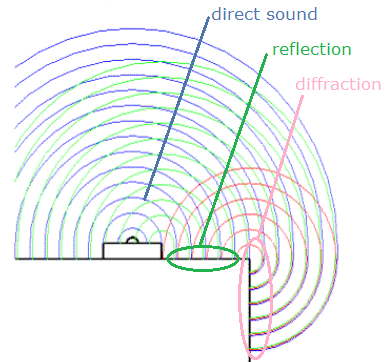After watching that video I moved the treatments I already had to the suggested locations, wow! I previously had absorption on the front wall in addition to those bass traps in the corners (pics in my profile). I replaced the absorption panels with two combo panels and big difference.
Then I followed the rest of the "recipe" interleafing absorbers and diffusors, etc. I bought most of my treatments through auralex and found great results at reasonbale prices, especially the diffusors. If I were starting from scratch I would just get a room kit from anthony's company, www.sonitususa.com.
Absorption, Diffusion or a combination of it all?
Looking to add more acoustic treatment on the wall behind the speakers. Currently using GIK absorption panels (242).
Planning to add two more panels that would hang pretty much directly behind the speakers on the upper part of the wall (higher quality image on my system page).
Any benefit going with diffusors?
Thanks!!!
- ...
- 74 posts total
In acoustical terms 99% of our rooms are small - 30x20x12 or 15x13x8 both are small acoustically speaking. However those two room sizes will require different approaches. Small room acoustics are very challenging. The challenge is to get the most out of your space and spkr placement / listening position and addressing room acoustics are the single biggest influence on a system, more than any piece or gear IMHO. I’m not into HT, only 2-chnl, but generally speaking many of the same principles apply
These are just some basic ideas, but get a mic and REW and measure your room is where I’d start. Also, I think its a matter of priorities as well. If you are fine with "whatever" and it sounds fine, that’s cool. If you want the very most from your system and are willing to put in the time, you must deal with spkr positioning and room acoustics, no way around it. DSP and the like are also no substitution / fix. Get the above right first, then if one wants to dabble with DSP, that comes last IMHO.
|
@mrskeptic: Paul McGowan is the founder of PS Audio. Is he a "scientist"? Certainly not. Is he a blow-hard? Yes. His "books" are full of dubious and self-serving claims, as are many of his too many Youtube videos. I also know people in the business who have expressed skepticism about him for various troubling reasons. However, many regard PS Audio as a serious audiophile manufacturer, and McGowan’s videos as sources of well-informed advice ("well-informed" meaning: lots of industry experience in high-end audio; that cuts several ways, of course). I own one of his earlier DACs, and love it. Make of his advice what you will. Now, I’m not an acoustician. But I do have a lot of education (make of that what you will as well), and I’ve published on issues in contemporary physics. As I understand it, sound absorption works by converting the energy of sound waves into heat energy. So, no, wood does not absorb sound until it "can hold no more" at which point the sound either "leaks out" or the wood "explodes." Anyone with the tag "mrskeptic" should be ashamed at such silliness. The way sound absorption works, in terms of physics, is well understood and explained in many available places. As for whether or not softer woods would absorb more than harder woods—I admit my ignorance on this, but it does make physical sense. In general, softer materials (pillows, heavy carpets, foam, acoustic panels, etc.) do, in fact, absorb more than harder, "reflective" materials (dry wall, plaster, glass). As for @jeffseight’s caution that the DIY diffusion panels I described "will be heavy"—well, they can be (with hard, heavier woods like walnut attached to heavy acoustic panels that are large). But smaller panels made from lighter (softer) woods, like pine, attached to lighter boards, are not prohibitively heavy. Too heavy to mount with double-stick tape, but not at all too heavy for other sorts of methods (such as are used for hanging even large and very heavy framed pictures). Finally, yeah, all this is tweaking, and usually unnecessary. Or...it can make a bigger difference than an expensive new component. FWIW, I totally agree with @redlenses03: room acoustics is one of the very most important elements in getting good sound. I’ve posted about this at length elsewhere on this forum (regarding concert halls, in particular, with respect to the recent renovation of Avery Fisher/Geffen Hall in NYC). The Number One element in good sound, however, is the quality of the original recording. There are plenty of "experts" who will second that opinion. Speakers are No. 3. After that, it’s all tweaks. Even amplification, so long as it’s sufficiently powerful not to be driven into clipping, has been empirically shown to be of relative unimportance. As for cables and power cords.... Of course, many on this forum don’t believe in empirical demonstrations. I hope, when you get sick, you don’t avoid empirically minded physicians, or disregard "measurements" when it comes to "high performance" vehicles. Science works. It’s not the endpoint of audiophilia, but it is certainly not irrelevant. |
@drbond - Have you tried diffusion behind your electrostatics? I started out with GIK Alpha Absorber/Diffusors behind my dipole speakers and was not happy with the soundstage and liveliness of the music. I switched to ATS Quadratic Residue Diffusors and really like the change (as did my audiophile friends). Of course, every room is different, and not everyone has the same preferences in sound presentation. But I've generally found manufacturers of dipole and open baffle speakers to recommend diffusion behind the speakers. I had thought that the GIK panels would have worked ok but they were sucking too much of the life out of the music. |
Perhaps I'm a purist. I want to hear the recording the way it was produced and intended to be heard. |
- 74 posts total


